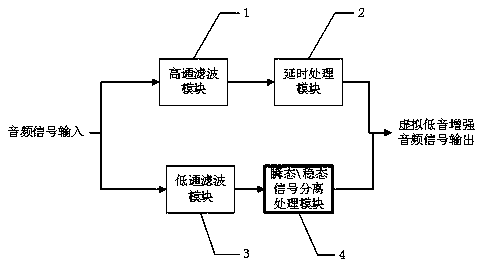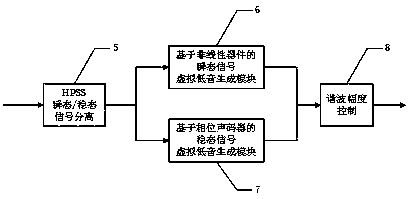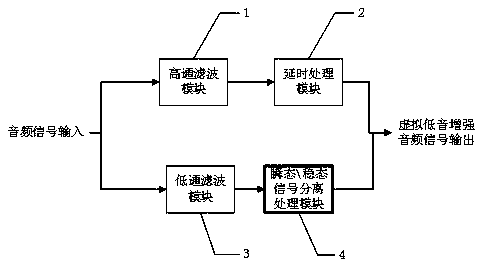Transient steady-state signal separation-based hybrid virtual bass enhancement processing method
A virtual bass, steady-state signal technology, applied in signal processing, transducer circuits, sensors, etc., can solve the problems of transient signal distortion, slow processing speed, non-linear distortion of steady-state signal, etc., to reduce steady-state distortion and transient distortion, enhanced loudness, enhanced bass effects
- Summary
- Abstract
- Description
- Claims
- Application Information
AI Technical Summary
Problems solved by technology
Method used
Image
Examples
Embodiment Construction
[0035] The present invention will be further described in detail below with reference to the embodiments and accompanying drawings, but the embodiments of the present invention are not limited thereto.
[0036] Based on the transient and steady-state signal separation hybrid virtual bass enhancement processing method of the present invention, the audio signal contains transient components and steady-state components, and the transient and steady-state components in the original audio signal are separated by a transient / stable signal separation algorithm. The components are separated, and then the virtual bass processing is performed through the virtual bass generation module based on the nonlinear device and the virtual bass generation module based on the phase vocoder, and then the obtained two-way virtual bass signals are controlled by harmonic amplitude to satisfy The equal loudness curves are synthesized into one channel, and finally the obtained virtual bass signal and the...
PUM
 Login to View More
Login to View More Abstract
Description
Claims
Application Information
 Login to View More
Login to View More - R&D
- Intellectual Property
- Life Sciences
- Materials
- Tech Scout
- Unparalleled Data Quality
- Higher Quality Content
- 60% Fewer Hallucinations
Browse by: Latest US Patents, China's latest patents, Technical Efficacy Thesaurus, Application Domain, Technology Topic, Popular Technical Reports.
© 2025 PatSnap. All rights reserved.Legal|Privacy policy|Modern Slavery Act Transparency Statement|Sitemap|About US| Contact US: help@patsnap.com



